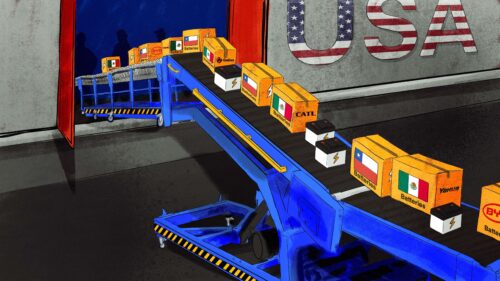EV startup Leapmotor is listing in Hong Kong, but its prospects are precarious
Chinese electric vehicle (EV) manufacturer Leapmotor has made low-end cars since it launched in 2015. As the company seeks to enter the mid- to high-end market, will the new IPO funds just disappear in a forlorn struggle for profitability?

On September 20, electric vehicle (EV) brand Leapmotor 浙江零跑科技 announced that it will be listing on the main board of the Hong Kong Stock Exchange on September 29, offering 131 million shares and expecting to raise about 7 billion yuan ($976.16 million).
The company plans to use 40% of the funds raised in the IPO for research and development, 25% to increase production capacity, 25% for marketing and sales expenses, and 10% for operating costs.
Leapmotor’s listing follows the IPOs of the triumvirate of new Chinese EV manufacturers that are sometimes called “Wèi Xiǎo Lǐ” 蔚小理: NIO 蔚来汽车, XPeng Motors 小鹏汽车, and Li Auto 理想汽车.
From surveillance to electric vehicles
The two men from Zhejiang Province behind Leapmotor, Zhū Jiāngmíng 朱江明 and Fù Lìquán 傅利泉, were the founders in 2001 of Dahua Technology 大华股份, a company that sells video surveillance products and services, and which is today one of the world’s leading surveillance equipment companies. Dahua listed on the Shenzhen Stock Exchange in 2008, and currently has a market capitalization of around 40 billion yuan ($5.57 billion).
In 2021, the surveillance industry news website IPVM reported that Dahua was using surveillance cameras and software to provide “‘real-time Uyghur Warnings” to the Chinese police, as explained in Dahua’s own technical documents.
At Dahua, Zhu and Fu noticed the clear trend of the automotive industry toward electrification and computing power, and also of vehicle-mounted cameras for autonomous driving. So in 2015, Zhu and Fu had a factory constructed for Leapmotor in Jinhua, Zhejiang Province. The company was initially funded by Dahua. From 2016 to 2019, Leapmotor had five rounds of financing that raised about 3 billion yuan ($418.35 million), and in 2021, Leapmotor raised about 8.8 billion yuan ($1.22 billion).
The company initially made cars in cooperation with Changjiang Auto 长江汽车, but in early 2021, Leapmotor took over the full production and assembly line.
The company has released four all-electric models so far, the S01 coupe, the T03 hatchback, the C11 SUV (from October 2021), and the C01 sedan (which was officially released today).
Cash bonfire
Leapmotor is also following in the footsteps of the Wei Xiao Li brands in another sense: burning through cash and still being far from profitable.
According to its prospectus, from 2019 to 2021, Leapmotor reported revenue of 117 million yuan ($16.31 million), 631 million yuan ($87.99 million), and 3.13 billion yuan ($436.76 million), respectively, and net losses of 901 million yuan ($125.64 million), 1.10 billion yuan ($153.39 million), and 2.84 billion yuan ($396.88 million). Over the three years, Leapmotor reported a net loss of 4.84 billion yuan ($675.92 million), and the company is expecting more net losses in 2022.
Leapmotor is going public with 2021 revenue of not much more than 3 billion yuan, which is significantly less than the Wei Xiao Li trio: When NIO went public in the U.S. in 2018, it had revenue of 4.95 billion yuan ($690.28 million) that year, and when Xpeng and Li Auto went public in the U.S. in 2020, they had revenues of 5.84 billion yuan ($814.39 million) and 9.46 billion yuan ($1.31 billion), respectively.
Leapmotor looks weaker than the Wei Xiao Li companies when looking at other factors:
- Although Leapmotor claims to target the mid- to high-end market, in reality, its cars are at the low end of the market. Yet the company plans to launch seven new electric models up to the end of 2025 in the mid- to high-end segments of the market, by which time the company wants to attain sales of 800,000 units.
- Even though the company claims to have fully independent research capabilities in all parts of the EV manufacturing process, Leapmotor’s investment in research and development of less than 1.4 billion yuan ($195.23 million) from 2019 to 2021 is far inferior to the 3-4 billion yuan that the three Wei Xiao Li brands spend on research and development each year. Leapmotor’s relative lack of investment in research and development is a particular concern for an EV company because, as one analyst put it, for makers of traditional fuel vehicles, it’s easy to build a “sofa on four wheels,” but for EV companies, it’s much harder to build a “computer on four wheels.”
Can Leapmotor leap up to the high end?
Leapmotor sold a total of 8,050 cars in 2020, an increase of 676% over 2019, and 43,748 cars in 2021 (mostly the T03 hatchback), an increase of 443% over 2020.
As of the end of July this year, Leapmotor had 443 stores in 151 cities in China, and the company plans to open its first flagship store in Europe in 2023. So far this year, Leapmotor’s sales (based on the T03 and the C11 SUV) have inched upward, from around 8,000 in January to over 12,500 in August, when it outsold all the Wei Xiao Li brands (only NIO was able to barely breach sales of 10,000 units). Overall, however, Leapmotor’s paltry sales of 12,525 in August placed it in 34th position when sales of all vehicle brands are considered, with the top three being VW (216,285 sales), BYD (173,977), and Toyota (161,481), and in 20th position when only Chinese brands are considered.
Like the Wei Xiao Li brands, Leapmotor is a long way from being profitable, and the struggle to get into the black is more difficult in the lower end of the market. From 2019 to 2021, the company’s gross profit margin was -95.7%, -50.6%, and -44.3%, respectively. In the first quarter of this year, it was -26.6%, while the gross profit margins of NIO, XPeng, and Li Auto in the same period were 18.1%, 10.4%, and 22.4%, respectively. So Leapmotor is still burning through cash at a frightening pace.
The company is now aiming to shift its focus to the mid- to high-end segments of China’s EV market, e.g., 150,000 yuan (around $20,000) to 300,000 yuan (just over $40,000). According to sales data, in 2021, this price range accounted for 39% of total EV sales in China, and this is expected to increase to 49% in 2026. But this segment is also the most competitive, and success for Leapmotor is by no means guaranteed. In 2021, Leapmotor relied for about 90% of its total sales on the T03 hatchback, a small vehicle in the 69,000-85,000 yuan ($9,600-11,900) price range. Much of the company’s hopes now rest on the C11 SUV (priced at up to 200,000 yuan or $27,900) and the brand-new C01 sedan (priced at up to 270,000 yuan or $37,700). But both these vehicles face a broad range of competitors.
It’s a tough environment for Leapmotor, and the road to profitability is going to be long and hard.
UPDATE, September 29: Leapmotor and Onewo shares tumble in Hong Kong debut / Reuters






